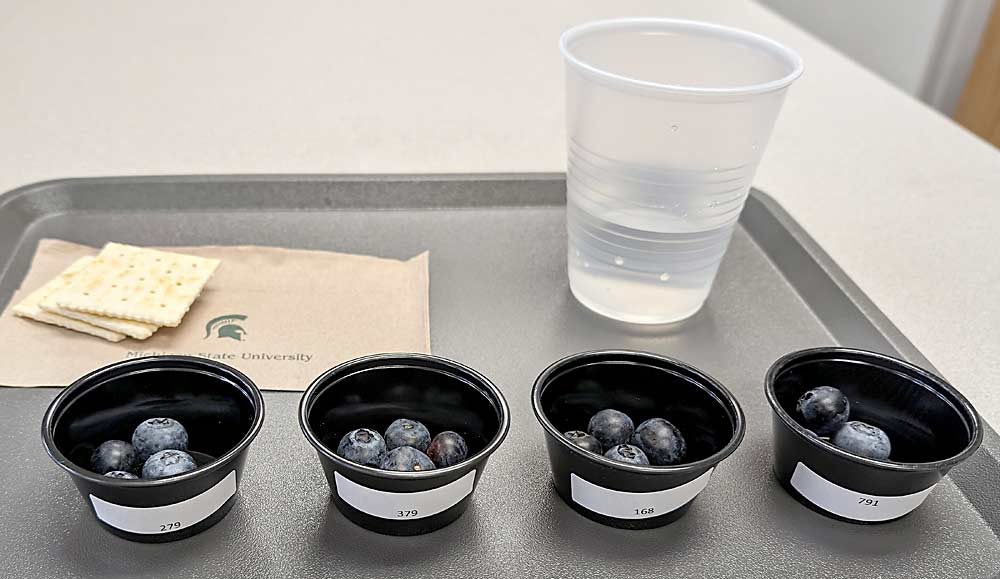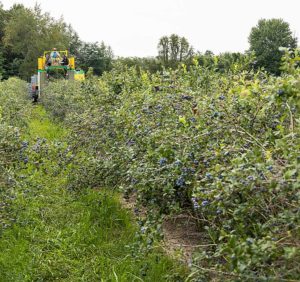—by Matt Milkovich

Michigan blueberry growers are replacing their older varieties with the newer, sweeter varieties consumers prefer, but the process is slow.
Michigan State University assistant professor and berry crops physiologist Josh Vander Weide said it will probably take a decade or two for Michigan growers to fully transition their fresh-market plantings to newer cultivars. New plantings are more intensive and expensive than they used to be, and an increasingly competitive global marketplace for blueberries limits profits.
In the meantime, consumers want sweeter berries, and retail chains have cooled on some of Michigan’s traditional varieties, which were bred more for firmness, yield and disease resistance rather than flavor and fruit quality.
So, how can the state’s growers keep up?
“We need strategies in place that can improve the quality and flavor of (existing) fresh-market blueberries while new plantings with better cultivars are being established,” Vander Weide said. “Nothing can really replace a cultivar with good-tasting fruit, but there are things we can do to help.”
Vander Weide and MSU food science and nutrition assistant professor Emily Mayhew are studying two methods to improve Michigan blueberries: delaying harvest and using plant growth regulators. Vander Weide learned both methods working with wine grapes in British Columbia.
Two years of trials have shown that applying plant growth regulators containing jasmonate hormones shortly before harvest can greatly increase the concentration of aroma compounds in blueberries, giving them a stronger flavor. The PGR project is funded by a Michigan Department of Agriculture and Rural Development Specialty Crop Block Grant. Jasmonic acids, commonly called JA, are phytohormones known to play a role in plants’ fruit development and stress responses.
It would be a simple enough solution: Add an extra product to the spray tank just before harvest to boost blueberry flavor. However, the PGRs they trialed aren’t registered for use on blueberries, and there’s no guarantee they will be, Vander Weide said.
Delaying harvest to boost flavor has more immediate potential. For this project, he chose to work with common Michigan varieties Duke and Draper, as well as Calypso, a newer variety with big, soft berries.
The first year’s data show that delaying the first harvest by a week can decrease a berry’s acidity level, giving it a sweeter flavor. They’ll gather another year of data before developing grower recommendations. The project is funded by MSU’s Project GREEEN initiative.
Michigan growers have made a habit of picking berries as soon as they turn blue, but for some varieties it might be better to wait longer, Vander Weide said.
“A lot of folks assume that ripening stops when fruit turn blue, but some things occur after turning blue to improve flavor,” he said.
But does waiting for greater sweetness come at the expense of firmness or shelf life? This year, Vander Weide plans to trial the effects of delayed harvest on shelf life. Calypso, with its larger and softer berries, showed a relatively large decrease in firmness in the trials; for Duke and Draper, the decreases were marginal.
“If you’re only sacrificing 5 percent of firmness for better-tasting fruit, I think that’s a good tradeoff,” he said.
Delayed harvest might also reduce the number of picks, which would save on labor costs, he said.
Vander Weide conducted delayed-harvest trials at Brookside Farms in Southwest Michigan, where the Fritz family grows 425 acres of blueberries. Their fresh, wholesale blueberries are harvested mainly by hand. Varieties include Duke and Draper, as well as a trial plot of Calypso, said grower George Fritz.
The big retail chains want large, flavorful fresh-market berries, and many traditional varieties don’t meet that standard, Fritz said. The prospect of waiting a few days to increase fruit quality before picking sounds promising to him.
“Anything to improve fruit quality always catches my ear,” he said.
Fritz used to delay harvest to gain better marketing windows for certain varieties, especially Elliott, which boosted late-season sales for years. But increased competition has rendered the late-season window less profitable. These days, it actually pays more to pick earlier, he said.
So, delaying harvest could push his berries into a less profitable market window, but it also could lead to the better flavor and fruit quality that consumers demand. Harvest timing is a juggling act, but as a fruit grower, Fritz is used to that. •







Leave A Comment